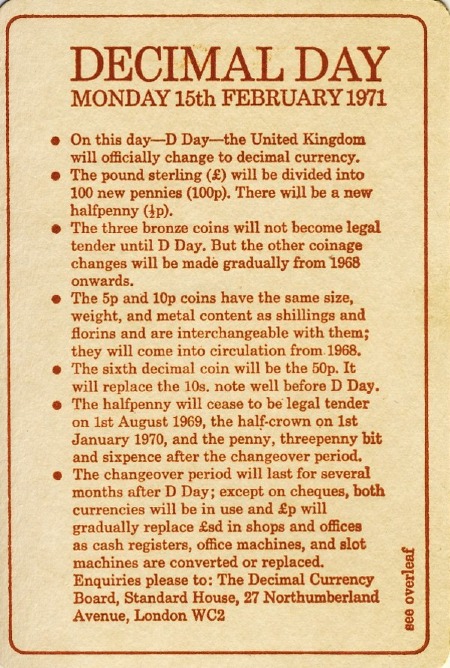英语听力万花筒 25 Old money, new money

When I was a child in the fifties and sixties, Britain had a wonderfully complicated currency system. We had pounds, like we do now, but each pound was divided into 20 shillings, and each shilling was divided into 12 pence, or pennies. So, at school we learned that “12 pence make one shilling, 20 shillings make a pound”. We had to learn our 12 times tables (that is our multiplication tables) very carefully, because we needed to be able to change pence into shillings and the other way round. So, we used to chant things like “seven sevens are forty-nine, forty-nine pence is four and a penny”. (“Four and a penny” was a common way of saying “four shillings and one penny”. ) There was even a special unit of currency called a guinea. A guinea was 21 shillings, or one pound and one shilling. Posh shops sometimes gave their prices in guineas instead of pounds.
We had a complicated set of coins to go with our complicated currency. The smallest coin was a farthing. It was worth a quarter of a penny, and I remember that it had a picture of a little bird – a wren – on one side. Of course a farthing was worth very little and we stopped using it in 1960. Then there was a half-penny, or a ha’penny as we called it. There was a one penny coin, and a strange coin for three pence – it was not round, but had 12 straight sides. We called it a “thru’penny bit”. There was a little silver 6 pence coin, and a bigger shilling coin. There was a coin for two shillings which we called a ‘florin’ and another one for two shillings and six pence which we called a ‘half crown’. Then there was a bank note for 10 shillings, as well as banknotes for one pound and for larger amounts.
Because we had had the same system of coins for many years, it was quite common to find 19th century coins, from the reign of Queen Victoria, in our change. (“Change” means the money which a shop-keeper gives back to you when you pay too much for something). The Queen Victoria coins were often worn almost smooth with use, though you could still see Victoria’s head – she looked cross and bad tempered. The inscription on the coins told us (in Latin) that she was Queen of Britain and Empress of India!
People who visited Britain were very puzzled by our money. Almost everywhere else in the world had a big unit of currency (like the US dollar, or the French franc or the German mark) which was divided into 100 smaller units (like cents, centimes, or pfennigs). By the mid-1960s, our government had decided that we had to do the same. Multiplying and dividing by 12 and by 20 was too complicated. We had to fall into linewith the rest of the world, and have a decimal currency (that is, a currency with units of 10, 100 etc).
So, the government designated 15 February 1971 as D-day, or “decimal day”, when we would start to use the new currency – a pound, divided into 100 pence. The Royal Mint (the government department responsible for issuing coins and bank notes) issuedshiny new coins, and for several months we used the old coins and the new coins together. There were, of course, some problems. Some people found it difficult to convert from old money to new money – for example, to remember that the old half-crown was now worth twelve and a half new pence. Other people complained that shopkeepers had used the new decimal currency as a way to put up prices. Small boys discovered that the new half-penny coin was exactly the same size as the old six-pence coin, and that they could use it in slot-machines which sold bars of chocolate. But the problems were only temporary, and we quickly got used to the new currency, and we found that it was after all easier to count in 10s.
After we had changed our currency, it was natural to think about changing other things, like our ways of weighing things or of measuring distances. We have traditional weights and measures in Britain which are even more complicated than our old currency. Gradually, over the last 30 years, we have changed to using metric measures like kilos and metres, partly because the European Community wants a common system in all European countries. We are still allowed to use some of the old measures, however. If you go into a British pub, for example, you should ask for a pint of beer, not half a litre of beer. Few people now regret “decimal day”. It is only really old people like me who remember when half a crown was a lot of money!
扩展阅读:
最新版英语听力
- 频道推荐
- |
- 全站推荐
- 推荐下载
- 网站推荐




















